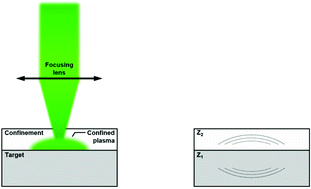Transition of elastomers from a rubber to glassy state under laser shock conditions
Abstract
The mechanical behaviour of polycarbonate and polydimethylsiloxane (Sylgard184) is studied in this work under laser shock conditions that induce high pressure and strain rates. Laser shock, usually used to reinforce metals, is chosen here because of its capacity to produce strain rates in the 106 s1 range and pressures of GPa order. The pressure and strain rates produced are extracted from the backface velocity profiles and reproduced with the FEM simulation on Abaqus for each laser shot. These two parameters lead to a glass transition shift in the polymers that can induce significant behaviour modifications. We show that Sylgard184, an elastomer with a glass transition temperature of 147 K, exhibits glassy behaviour under such laser shock conditions. By contrast, polycarbonate is already a glassy polymer in its normal state with a glass transition temperature of 415 K; no drastic change in behaviour under shock is evidenced. To discuss these findings in relation to the different mobility domains of the polymer chains under extreme conditions, dielectric relaxation spectroscopy (DRS) measurements are performed to characterize the limits of the rubbery and glassy behaviour for both polymers. As a result, the coupling of the two techniques provides a deeper understanding of the contribution of both the strain rate and pressure to the dynamic glass transition in polymers and thus expands the experimental study range of the two polymers to a strain rate that had not previously been reached.



 Please wait while we load your content...
Please wait while we load your content...